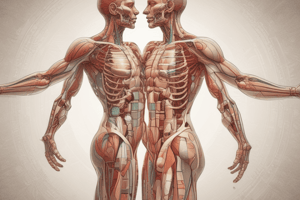Podcast
Questions and Answers
What percentage range does water constitute of the average adult's weight?
What percentage range does water constitute of the average adult's weight?
- 30-40%
- 50-60% (correct)
- 10-20%
- 90-100%
Which of the following is a primary function of water in the body?
Which of the following is a primary function of water in the body?
- Providing energy for muscle contraction
- Synthesizing hormones
- Forming structural components of bones
- Regulating body temperature and transporting nutrients (correct)
What mechanisms primarily regulate fluid balance in the body?
What mechanisms primarily regulate fluid balance in the body?
- Muscle contractions and nerve impulses
- Digestive enzymes and metabolic rate
- Respiration rate, body movement and skin temperature
- Homeostasis, excretion, and hormones (correct)
Which condition may result from fluid volume deficit (FVD)?
Which condition may result from fluid volume deficit (FVD)?
What factors can increase the risk of fluid volume deficit (FVD)?
What factors can increase the risk of fluid volume deficit (FVD)?
What is a common sign of fluid volume excess (FVE)?
What is a common sign of fluid volume excess (FVE)?
Which scenario would most likely lead to fluid volume excess (FVE)?
Which scenario would most likely lead to fluid volume excess (FVE)?
What is the role of electrolytes?
What is the role of electrolytes?
What is the main function of Iron as a trace mineral?
What is the main function of Iron as a trace mineral?
What is the primary function of zinc as a trace mineral?
What is the primary function of zinc as a trace mineral?
What role does iodine play as a trace mineral?
What role does iodine play as a trace mineral?
What is Fluoride's primary function in the body as a trace mineral?
What is Fluoride's primary function in the body as a trace mineral?
Which process is significantly influenced by Sodium?
Which process is significantly influenced by Sodium?
What is the main function of Potassium in the body?
What is the main function of Potassium in the body?
What is Chloride's primary role in the body?
What is Chloride's primary role in the body?
What is a key function of Calcium in the body?
What is a key function of Calcium in the body?
What is the function of Phosphorus in the body?
What is the function of Phosphorus in the body?
What is the role of Magnesium in the human body?
What is the role of Magnesium in the human body?
What is the possible effect of excessive sodium intake?
What is the possible effect of excessive sodium intake?
What condition is characterized as the most prevalent bone disease and affects millions of people worldwide?
What condition is characterized as the most prevalent bone disease and affects millions of people worldwide?
Which of the following poses a heightened risk of fluid and electrolyte imbalances?
Which of the following poses a heightened risk of fluid and electrolyte imbalances?
In which of the following processes is water directly involved?
In which of the following processes is water directly involved?
What percentage range does water constitute of an infant's weight?
What percentage range does water constitute of an infant's weight?
Which of the following can affect calcium absorption in the body?
Which of the following can affect calcium absorption in the body?
Which of the following is impaired as a result of electrolyte imbalances?
Which of the following is impaired as a result of electrolyte imbalances?
Flashcards
Role of Water & Minerals
Role of Water & Minerals
Water and minerals are essential components of body fluids and perform various functions in the body, maintaining overall health and well-being.
Water Content in the Body
Water Content in the Body
Water constitutes 50-60% of average adult weight and 75-80% of infant weight.
What is FVD?
What is FVD?
Fluid Volume Deficit (FVD) is a state of dehydration, either vascular, cellular, or intracellular.
What is FVE?
What is FVE?
Signup and view all the flashcards
Defining Electrolytes
Defining Electrolytes
Signup and view all the flashcards
What is Iron's Role?
What is Iron's Role?
Signup and view all the flashcards
Role of Zinc
Role of Zinc
Signup and view all the flashcards
Role of Iodine
Role of Iodine
Signup and view all the flashcards
Role of Fluoride
Role of Fluoride
Signup and view all the flashcards
What is Osteoporosis?
What is Osteoporosis?
Signup and view all the flashcards
Electrolytes Definition
Electrolytes Definition
Signup and view all the flashcards
Fluid Volume Deficit (FVD)
Fluid Volume Deficit (FVD)
Signup and view all the flashcards
Fluid Volume Excess (FVE)
Fluid Volume Excess (FVE)
Signup and view all the flashcards
Water and Minerals Role
Water and Minerals Role
Signup and view all the flashcards
Causes of FVD
Causes of FVD
Signup and view all the flashcards
Causes of FVE
Causes of FVE
Signup and view all the flashcards
FVD High-Risk Groups
FVD High-Risk Groups
Signup and view all the flashcards
Definition of Electrolytes
Definition of Electrolytes
Signup and view all the flashcards
What does Iron do?
What does Iron do?
Signup and view all the flashcards
What does Zinc affect?
What does Zinc affect?
Signup and view all the flashcards
Iodine function
Iodine function
Signup and view all the flashcards
What does Fluoride help?
What does Fluoride help?
Signup and view all the flashcards
Electrolytes functions
Electrolytes functions
Signup and view all the flashcards
Study Notes
- Water and minerals are key components of body fluids and perform various functions.
Water
- Water is derived from food sources
- Factors to asses include water quality, structure, absorption, metabolism, and function.
- Water makes up 50-60% of adult weight and 75-80% of infant weight
Regulation of fluids
- Homeostasis is key in fluid balance
- Excretion and hormones play a role
Fluid and Electrolytes
- Imbalances may occur resulting in fluid volume deficit (FVD)
- Results in vascular, cellular, or intracellular dehydration
- Causes of FVD: diarrhea, vomiting, high fever, diuretics, sweating, polyuria
- Those most at risk are elderly people and infants
- Imbalances may also occur resulting in fluid volume excess (FVE)
- Results in increased fluid retention and edema
- Causes include sodium retention, water intoxication
Minerals
- Minerals are categorized for assessment
- Foods are sources of minerals and should be examined
- Factors to asses include structure, digestion and absorption, and metabolism
- Calcium is a major mineral with a function and regulation
- Recommended intake and sources are considerations
- Absorption factors, deficiency and toxicity also need to be considered
Osteoporosis
- Osteoporosis is the most prevalent bone disease
- 1.5 million osteoporotic fractures occur each year
- 10 million Americans suffer from the disorder
- 33.6 million Americans suffer from osteopenia
Other minerals
- Phosphorus is a major mineral and factors to consider include function, sources, deficiency and toxicity
- Magnesium is a major mineral and factors to consider include function, recommended intake and sources, deficiency and toxicity
- Electrolytes are minerals circulating in blood and other body fluids with an electric charge
Electrolytes
- Sodium is a major electrolyte, factors to consider include function, recommended intake and sources, deficiency, and excess.
- Potassium is a major electrolyte, factors to consider include function, sources, deficiency, and excess.
- Chloride is a major electrolyte, factors to consider include function, sources, deficiency, and excess.
Trace Minerals
- Iron distributes oxygen.
- Zinc relates to growth process
- Iodine relates to thyroxine synthesis
- Fluoride is key to bone and tooth formation
Studying That Suits You
Use AI to generate personalized quizzes and flashcards to suit your learning preferences.




